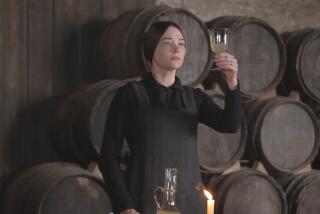Du Maurier is alive in this tale
- Share via
JUSTINE PICARDIE’S “Daphne,” which focuses on Daphne du Maurier’s life in crisis as she turns 50 and prepares to celebrate her silver wedding anniversary, is an engrossing and absorbing read. And as if her ability to bring to life so convincingly the eponymous heroine were not enough, Picardie’s novel touches on several other worlds guaranteed to draw crowds. For who can resist the Brontes (Du Maurier is writing a biography of Charlotte, Anne and Emily’s brother Branwell)? Or the Du Maurier legacy (her father, Gerald, was the leading matinee idol of his day; her grandfather, George, was the creator of Svengali in his classic novel “Trilby”)? Or Du Maurier’s connections to J.M. Barrie’s “lost boys” who inspired “Peter Pan” (her first cousins) and the British royal family (her husband is Lt. Gen. Sir Frederick Browning, treasurer to Prince Philip)? All this -- and much more -- adds up to a delicious and piquant stew of interlocking worlds and desperate people, told with considerable panache and much psychological insight.
The novel operates on three levels. Du Maurier struggles in 1957 with her husband’s nervous breakdown and subsequent retirement from Buckingham Palace after his disastrous affair with a woman she dubs “The Snow Queen.” J. Alexander Symington, a seedy, defrocked Bronte curator of dubious reputation and flawed conduct, corresponds with Du Maurier, tempting her with tidbits about Branwell that turn out to be of little value despite the money he manages to extract from her. A half-century later, a young academic obsessed with -- and planning to write about -- Du Maurier studies the novelist as she struggles with her own demons in the form of a distant husband, his forbidding house and his impressive ex-wife.
This situation, of course, replicates -- but without “Rebecca’s” sturm und drang -- the situation of Du Maurier’s most celebrated novel; and this young woman, like its narrator, lacks a first name as she tells her tale in the first person. Artful as Picardie’s homage is, these sections of the book are the novel’s weakest. Perhaps she thought that readers needed them as a guide to Daphne’s turmoil and Symington’s desperate decline, but those parts are so electric in their capacity to attract that the plodding, pallid 21st century players seem superfluous. But no matter: with such a pathetic con man and a multifaceted character like Daphne, both superbly evoked, our cup runneth over.
The title is indeed apt, for Daphne is the heart and soul of the novel. Clearly Picardie has lived, breathed, eaten and drunk her heroine, absorbed her, analyzed her, understood her. More remarkable, she has then managed to do all these things as Daphne du Maurier in the pages of her book, investing her portrait with an authenticity that is breathtaking. To be able to capture as contradictory a character as Du Maurier -- her personality, her complicated sexuality, her artistry as a writer -- is impressive enough. But even though Picardie writes about her in the third person, she seems able to channel what she was actually like: all that passion bubbling away under the stiff upper lip of Lady Browning.
In a scene set in London’s Cafe Royal, Daphne is explaining to her cousin Peter Llewellyn Davies her obsessive foray into Bronteland. He replies: “It sounds to me like you’ve got under Branwell’s skin. Or has he got under yours?” Exactly what we see happening between Picardie and Du Maurier in these pages.
One of the benefits of the feminist revision of literary history and criticism has been to rescue talents like Du Maurier from the ghetto of those days’ equivalent of chick lit, where a patronizing and obtuse male-dominated establishment had consigned them. At her best, Du Maurier produced innovative fiction packed with dramatic situations and psychological insight. (It is no accident that her fiction was the basis for two of Hitchcock’s iconic films, “Rebecca” and “The Birds.”) With a charismatic father she adored and whose quasi-incestuous love for her influenced her profoundly, Daphne was even more complicated as a person. Largely heterosexual, on occasion what she termed “the boy in the box” popped out, leading to serious passions for the wife of her American publisher Ellen Doubleday and the star actress Gertrude Lawrence, who had been her father’s mistress. Her ability to juggle celebrity as an author, tumultuous extramarital affairs with both men and women and life as a country gentlewoman and courtier’s wife hobnobbing with royalty took its toll on her inwardly, making her biography as fascinating as her fiction.
Picardie’s “Daphne” will make many readers want to read Du Maurier’s work, both fiction and non, most of it now reissued by Virago Press, which has also published the fascinating “The Daphne du Maurier Companion” (edited by Helen Taylor), full of information about her life and work in essays by many hands including Picardie’s. Not surprisingly, she contributes an essay on “The Infernal World of Branwell Bronte,” and she also writes one about “The King’s General,” a historical novel set in 17th century Cornwall. One way or another, Picardie is making a major contribution to the continuing upward reevaluation of Daphne du Maurier’s standing in the literary world.
--
Martin Rubin is a critic and the author of “Sarah Gertrude Millin: A South African Life.”
More to Read
Sign up for our Book Club newsletter
Get the latest news, events and more from the Los Angeles Times Book Club, and help us get L.A. reading and talking.
You may occasionally receive promotional content from the Los Angeles Times.









